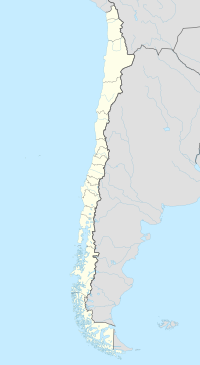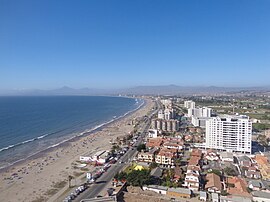La Serena (Chile)
| La Serena | |
|---|---|
|
Coordinates: 29 ° 54 ′ S , 71 ° 15 ′ W
La Serena on the map of Chile
|
|
| Basic data | |
| Country | Chile |
| City foundation | 1543 |
| Residents | 196,178 (2017) |
| - in the metropolitan area | 401.938 |
| City insignia | |
| Detailed data | |
| height | 28 m |
| Serena Beach | |
La Serena is a city in the little north of the South American Andean state of Chile . It has 196,178 inhabitants (as of 2017). Its charm is made up of the colonial style (listed), but the city is also perceived as a kind of oasis in the middle of the desert. The La Serena- Coquimbo agglomeration is the fourth largest in the country.
geography
La Serena is located directly on the Pacific , about 470 km north of Santiago , not far from the city is Coquimbo. To the east lies the Valle del Elqui . It is formed by the Río Elqui and is the northernmost wine-growing region in Chile. The Cerro Grande rises directly behind the city .
climate
Average annual temperatures are around 14 ° C. It hardly rains. In La Serena the Atacama Desert begins , but there are often clouds.
|
Average monthly temperatures and rainfall for La Serena
Source: wetterkontor.de
|
||||||||||||||||||||||||||||||||||||||||||||||||||||||||||||||||||||||||||||||||||||||||||||||||||||||||||||||||||||||||||||||||||||||||||||||||||||||||||||||||||||||||||||||||||||||||
history
The first city the Spaniards founded in the Coquimbo region was La Serena. It is the second oldest city in Chile. Juan Bohón founded it on November 15, 1543 as a seaport connecting Santiago de Chile and Lima in Peru . However, the city was destroyed again on July 22, 1549 by attacks by the natives. Francisco de Aguirre practically re-founded on August 26, 1549 and named it San Bartolomé de La Serena . On May 4, 1552, the Spanish King Charles V officially named the city La Serena.
The city has been subject to frequent attacks by English pirates such as Bartholomew Sharp in 1680 and Edward Davis in 1686. Around 1700 it was expanded into a fortress against pirate attacks. In 1801 and 1847 the city was hit by severe earthquakes .
Since 1840 the city has been the seat of a Roman Catholic diocese , which was elevated to the Archdiocese of La Serena in 1939 .
Around 1920 the city became an important port due to large iron ore finds.
economy
La Serena is a popular tourist destination . The city lies on the Panamericana .
Attractions
The heart of the city is the Plaza de Armas with its cathedral and other churches. There are small markets and cozy shopping streets. The city has several museums to offer.
There are several beaches with white sand.
A day trip to Isla de Damas is ideal , as are trips to the valleys of the region.
A detour to the nearby Elqui Valley , the location of several internationally important space observatories, where supposedly the clearest starry sky in the world can be observed at night is also highly recommended . But the valley also has its charms during the day: the vegetation, irrigated by the river and in lush green tones, stands in impressive contrast to the semi-arid surroundings. So you have the feeling of being in a slightly different world, in a real oasis.
Observatories
Due to the usually very good quality of the night sky in the sparsely populated area of the city, favored by the near-desert climate, La Serena is the seat of several large astronomical observation institutions, including the Las Campanas Observatory and the Inter-American Observatory on Cerro Tololo .
Town twinning
-
Millbrae , California, United States

-
Hilo , Hawaii, United States

sons and daughters of the town
- Antonio Guerrero (1886–1959), Chilean-Canadian composer, pianist and piano teacher
- Manuel Magallanes Moure (1878–1924), writer and literary critic
- Bartolomeo Blanche Espejo (1879–1970), politician and military officer
- Gabriel González Videla (1898–1980), politician
- Jorge Urrutia Blondel (1905–1981), composer
- Alejandro Guillier (* 1953), sociologist, journalist and politician
- Pepe Aguirre († 1988), tango singer
- Pedro Carmona-Alvarez (* 1972), Norwegian novelist, poet and musician
- Carlos Villanueva Rolland (* 1986), football player
See also
- List of cities in Chile
- Website of the city of La Serena
- Photos from La Serena-Coquimbo









